They say cleanliness is next to godliness bathe your dog, but when it comes to our furry friends, how often should we bathe them? Like a fish out of water, finding the perfect bathing routine for your dog can be quite a challenge. The frequency of baths will depend on various factors such as breed, coat type, lifestyle, and health. As the saying goes, ‘Different strokes for different folks,’ each dog has unique needs that must be considered.

In this article, we will explore the key considerations when determining how often you should bathe your canine companion. By examining their breed and coat type, assessing their lifestyle and activities, using quality products and establishing a bathing routine, practicing proper techniques while considering their health and sensitivities – you’ll become well-equipped in maintaining good hygiene for your beloved pet.
So let’s dive in and find the perfect balance between cleanliness and comfort for our faithful companions!
Key Takeaways
- The frequency of bathing dogs depends on breed, coat type, lifestyle, and health.
- General rule of thumb is to bathe dogs every two to four weeks, but individual factors should be considered.
- Use high-quality dog shampoos and conditioners specifically formulated for dogs, avoiding harsh chemicals.
- Regular bathing removes allergens, controls odors, promotes healthy skin, and allows for early detection of skin abnormalities.
Consider Your Dog’s Breed and Coat Type
Consideration of your dog’s breed and coat type is vital when determining how often to bathe them. Choosing the right grooming tools is important in maintaining a healthy and clean coat for your furry friend.
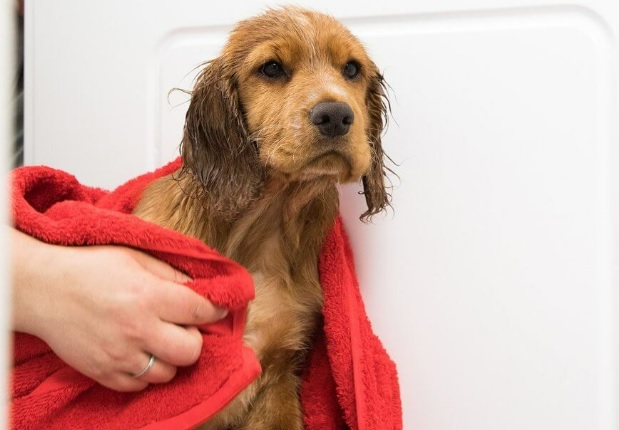
Different breeds have different coat types, such as short or long, wiry or curly, and double-coated or single-coated. These variations affect the frequency of professional grooming required for each individual dog.
Breeds with longer hair or those that shed heavily may need more frequent bathing to prevent matting and tangling. On the other hand, dogs with shorter hair or less shedding may require less frequent bathing.
It is crucial to consult with a professional groomer who can provide guidance on the specific needs of your dog’s breed and coat type to ensure their overall well-being and hygiene.
Assess Your Dog’s Lifestyle and Activities
Assessing your dog’s lifestyle and activities is crucial in determining the appropriate frequency of bathing.
One important factor to consider is their diet. Bathe your Dogs with a high-fat or oily diet may require more frequent bathing to prevent their coats from becoming greasy and smelly.
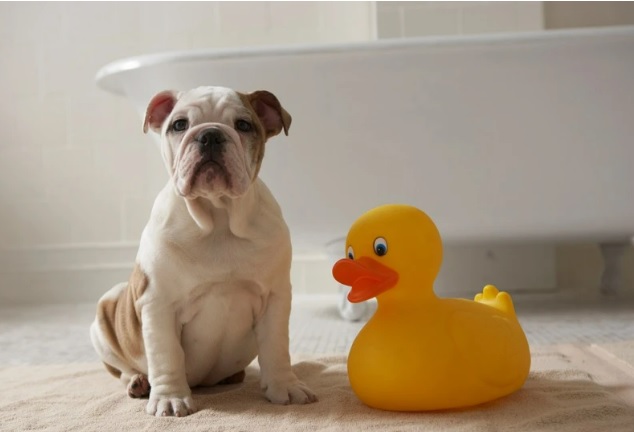
Additionally, dogs that engage in regular exercise or outdoor activities may get dirty more quickly and therefore need more frequent baths.
On the other hand, dogs that spend most of their time indoors and have a sedentary lifestyle may not require bathing as often.
It is essential to strike a balance between maintaining good hygiene and avoiding excessive bathing, which can strip away natural oils from the dog’s skin and coat, leading to dryness and irritation.
By assessing diet and considering exercise levels, you can determine how often your dog should be bathed to keep them clean and comfortable without compromising their overall health.
Follow the General Rule of Thumb
One key aspect to keep in mind when determining the appropriate frequency of bathing for your dog is following the general rule of thumb.
While there isn’t a one-size-fits-all answer, it is generally recommended to bathe your dog every two to four weeks. However, it’s essential to consider bathing frequency based on individual factors.
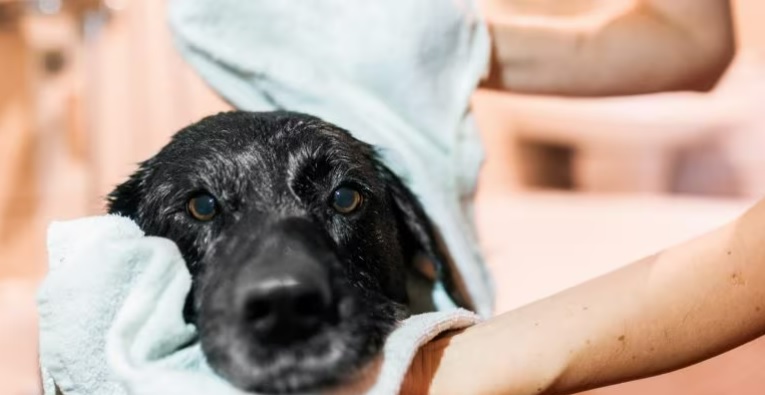
Factors such as breed, coat type, and lifestyle should be taken into account. Dogs with oily skin or allergies may require more frequent baths, while dogs with dry skin may benefit from less frequent bathing.
Additionally, outdoor activities and exposure to dirt or allergens can also influence how often you should bathe your dog. It’s important to assess your dog’s specific needs and adjust the bathing frequency as needed to maintain their cleanliness and overall health.
Use Quality Dog Shampoos and Conditioners
Using high-quality dog shampoos and conditioners is crucial for maintaining the cleanliness and health of your pet.
When it comes to choosing the right dog shampoo and conditioner, there are a few factors to consider. Firstly, opt for products that are specifically formulated for dogs, as human shampoos can be too harsh and may cause skin irritation.
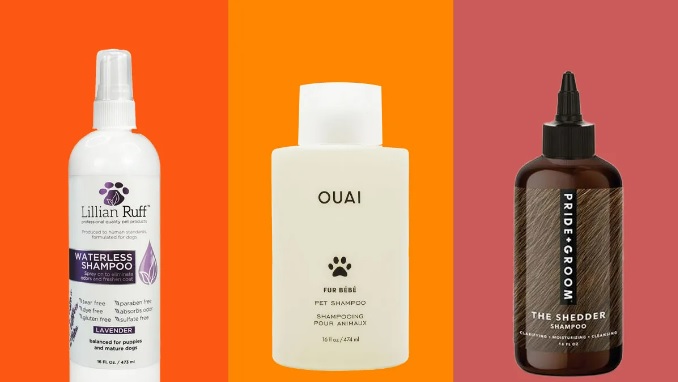
Secondly, look for shampoos and conditioners that are free from artificial fragrances, colors, and harsh chemicals. These additives can potentially harm your dog’s skin and coat.
Lastly, consider using natural or organic options that contain ingredients like oatmeal or aloe vera, which can soothe sensitive skin and provide additional nourishment.
By following proper grooming techniques and using quality products, you can ensure that your dog maintains a clean and healthy coat while minimizing the risk of any adverse reactions.
Establish a Bathing Routine
Consistency and regularity are key when it comes to establishing a bathing routine for your dog. By sticking to a set schedule, you can ensure that your furry friend is always clean and groomed. This also helps in maintaining their overall health and hygiene.
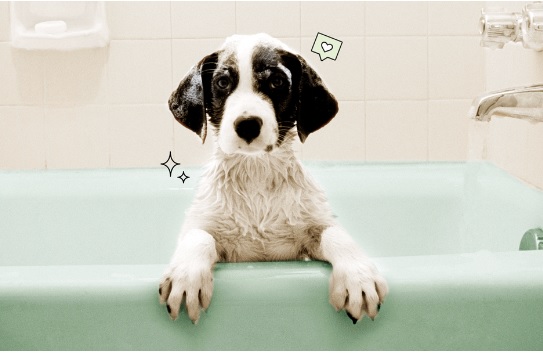
Additionally, it is important to gradually introduce puppies to the bathing process, as they may be unfamiliar with it at first. This allows them to become more comfortable and less anxious during bath time.
Consistency and regularity Bathe Your Dog
Regular and frequent bathing of dogs is essential for maintaining their hygiene and overall health, as it helps to prevent the accumulation of dirt, bacteria, and parasites on their fur and skin. A consistent dog bathing frequency offers several benefits that contribute to the well-being of both the dog and its owner.
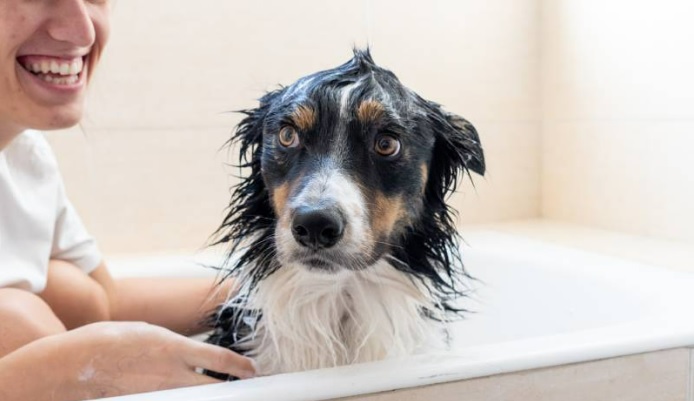
Firstly, regular bathing removes allergens from the dog’s coat, reducing the risk of allergic reactions in sensitive individuals.
Secondly, it helps to control odors by eliminating smells that can be unpleasant for people living with or near dogs.
Additionally, consistent bathing promotes healthy skin by preventing excessive oil buildup and reducing the likelihood of skin infections.
Moreover, it allows for early detection of any abnormalities such as lumps or bumps on the skin that may require veterinary attention.
Lastly, a regular bath routine provides an opportunity for bonding between dogs and their owners while ensuring they look clean and presentable at all times.
Gradual introduction for puppies
A gradual introduction to bathing is crucial for puppies as it helps them develop a positive association with the experience and ensures their comfort and safety during future bathing sessions.
By implementing gradual introduction techniques, such as initially using just warm water or allowing the puppy to explore the bathtub without water, owners can help their puppies become familiar with the bathing environment before introducing soap and shampoo.
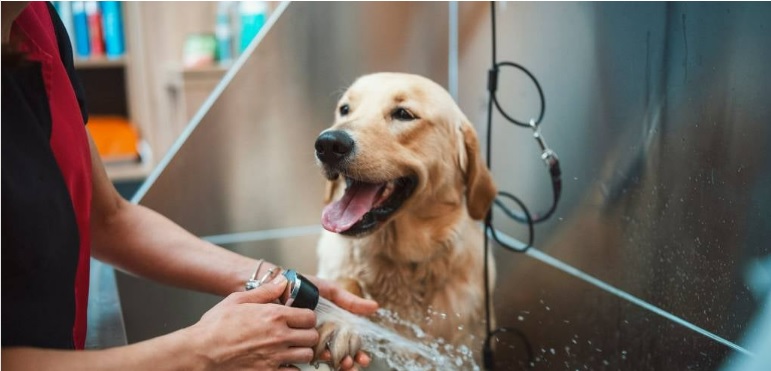
This approach allows puppies to adjust at their own pace, reducing anxiety and fear associated with bath time.
Additionally, by gradually increasing the frequency of baths over time, puppies can benefit from increased socialization opportunities. Regular exposure to different grooming practices can contribute to their overall well-being by making them more comfortable in various situations and improving their interactions with humans and other animals.
Pay Attention to Signs of Dirty or Smelly Dog
One must remain vigilant and observe any indications of an unclean or malodorous canine companion. Paying attention to grooming habits is essential in identifying when a dog needs a bath. Regularly checking for signs of skin irritation, such as excessive scratching or redness, can also indicate that it is time for a bath. Additionally, a strong unpleasant odor emanating from the dog’s coat may be another sign of dirtiness and should not be ignored.
To assist in recognizing these signs, here are two sub-lists:
- Pay Attention to Grooming Habits:
- Observe if the dog’s coat appears oily or greasy.
- Take note if there are any mats or tangles forming in the fur.
- Signs of Skin Irritation:
- Look for redness, inflammation, or rashes on the dog’s skin.
- Notice if the dog frequently scratches or licks certain areas excessively.
By being attentive to these indicators, owners can ensure that their beloved pets receive appropriate bathing care when necessary.
Consider Your Dog’s Health and Sensitivities
Skin conditions and allergies are important factors to consider when determining how often to bathe your dog. Some dogs may have sensitive skin or be prone to allergies, which can be aggravated by frequent bathing. I
f your dog has a history of skin issues or develops any new symptoms such as itching, redness, or irritation after bathing, it is recommended to seek veterinary advice for proper diagnosis and guidance on the appropriate bathing frequency for your dog’s specific needs.
Skin conditions and allergies
Skin conditions and allergies, often a troublesome issue for our furry companions, can greatly impact the regularity with which we should bathe our dogs. When considering dog grooming and bathing frequency, it is essential to take into account any existing skin conditions or allergies that your dog may have.
Dogs with sensitive skin or allergies may require less frequent bathing to avoid exacerbating their condition. Over-bathing can strip the natural oils from their skin, leading to dryness and irritation. However, it is important to note that certain skin conditions may require more frequent bathing as part of a treatment plan prescribed by a veterinarian.
Therefore, consulting with a professional is crucial in determining the appropriate bathing schedule for your dog with specific skin conditions or allergies. By doing so, you can ensure that their grooming routine promotes optimal health and comfort while addressing any underlying issues they may have.
Seek veterinary advice if necessary
Consulting with a veterinarian regarding your dog’s grooming routine can be compared to seeking expert advice when navigating through unfamiliar territory, ensuring that you make informed decisions and provide the best care for your furry companion.
Seeking professional guidance is particularly important when dealing with skin conditions and allergies that may require specific bathing methods or products. Veterinarians possess the knowledge and experience necessary to identify underlying causes of these issues and recommend appropriate treatments. They can offer alternative bathing methods, such as medicated shampoos or frequency adjustments, tailored to address individual needs.
By relying on their expertise, dog owners can better manage skin conditions and allergies, promoting overall well-being for their beloved pets. It is always advisable to consult with a veterinarian before implementing any changes to a dog’s grooming routine in order to ensure the most effective care.
Practice Proper Bathing Techniques
This paragraph will discuss key points related to practicing proper bathing techniques for dogs.
Firstly, it is important to ensure that the water temperature during the bath is appropriate. Dogs are sensitive to extreme temperatures, so using lukewarm water is recommended.
Secondly, thorough rinsing is crucial to remove all shampoo and soap residue from the dog’s fur and skin. This helps prevent skin irritation and itching.
Lastly, proper drying techniques should be employed after the bath to avoid any discomfort or potential health issues such as fungal infections due to dampness on the dog’s skin.
Proper water temperature
Proper water temperature is a crucial factor to consider when bathing your dog. It ensures the comfort and safety of your furry friend during the grooming process. Using appropriate water temperature helps maintain their skin’s health and prevents any discomfort or irritation. Extreme temperatures, whether too hot or too cold, can be harmful to dogs. Hot water may scald their sensitive skin and cause burns, while cold water can shock their system and lead to hypothermia. To create an emotionally engaging experience for the audience, let us compare the effects of extreme temperatures on dogs using a table:
| Water Temperature | Effects on Dogs |
|---|---|
| Hot | Burns |
| Cold | Hypothermia |
By understanding the importance of maintaining proper water temperature while bathing our beloved pets, we can ensure their well-being and promote a positive grooming experience for them.
Thorough rinsing and drying
Thorough rinsing and drying after bathing is essential to ensure the cleanliness and comfort of dogs during the grooming process. Properly rinsing off all traces of shampoo and conditioner helps prevent skin irritation and potential allergic reactions in dogs with sensitive skin. It also ensures that no residue is left behind, which can attract dirt and cause odor.
Thorough drying is equally important as it prevents matting of the fur, especially in long-haired breeds. Wet fur can easily become tangled, leading to discomfort and potential health issues such as skin infections. To achieve thorough drying, it is recommended to use a towel or a blow dryer on a low heat setting.
Ensuring that the dog’s coat is completely dry before allowing them outside or exposing them to cold temperatures further promotes their well-being.
- Importance of thorough rinsing:
- Prevents skin irritation
- Avoids residue buildup
- Significance of thorough drying:
- Prevents matting
- Reduces discomfort
Maintain Good Hygiene Between Baths
Regular grooming and brushing of your dog’s coat helps to maintain good hygiene between baths, ensuring that their fur remains clean and free from tangles or matting. By regularly brushing your dog’s coat, you can remove dirt, debris, and loose hair that may accumulate over time.
This not only keeps their coat looking neat and tidy but also prevents odors and reduces the risk of skin infections. Additionally, maintaining cleanliness through regular grooming allows you to identify any issues with your dog’s skin or coat early on, such as fleas or ticks.
Grooming hacks like using a slicker brush for removing loose hair or a deodorizing spray for refreshing their scent can further enhance the hygiene of your furry friend between baths.
Overall, investing time in regular grooming practices helps keep your dog healthy and comfortable while promoting a well-groomed appearance.
Trust Your Instincts and Seek Professional Advice
Consulting with a veterinarian or professional groomer is essential when it comes to determining the best bathing routine for your dog.
These experts can provide valuable advice and guidance based on your dog’s specific needs, such as their breed, coat type, and any skin conditions they may have.
By seeking professional advice, you can ensure that you are taking the necessary steps to maintain your dog’s hygiene without causing any harm or discomfort.
Consulting with a veterinarian or professional groomer
Professional advice from a veterinarian or professional groomer is crucial in determining the appropriate bathing frequency for your beloved canine companion. These experts possess the knowledge and experience necessary to provide you with valuable professional grooming tips and guide you in finding the right groomer for your dog.
Consulting with a veterinarian or professional groomer allows you to receive personalized recommendations based on your specific dog’s breed, coat type, and overall health condition. They can assess factors such as allergies, skin conditions, outdoor activities, and general lifestyle to determine how often your dog should be bathed.
Additionally, these professionals can advise on suitable shampoos and grooming techniques that are best suited for maintaining optimal cleanliness without causing any harm or discomfort to your pet.
By seeking their expertise, you ensure that your canine friend receives the appropriate care and grooming regimen tailored specifically to their needs.
Personalizing your dog’s bathing routine based on their specific needs
Tailoring your dog’s bathing routine based on their individual needs allows for a personalized approach to cleanliness, ensuring optimal care and comfort for your canine companion.
When considering the frequency of bathing, it is important to take into account factors such as breed, coat type, and activity level.
Dogs with oily coats or skin conditions may require more frequent baths to maintain hygiene and prevent discomfort. On the other hand, breeds with dry skin or delicate fur may benefit from less frequent bathing to avoid stripping natural oils and causing irritation.
Additionally, dogs who spend a lot of time outdoors or engage in activities that result in dirt accumulation might need more regular baths compared to those who are primarily indoor pets.
By adjusting the bathing routine according to these specific needs, you can ensure that your dog remains clean and healthy without causing unnecessary stress or harm.
Frequently Asked Questions
Can I use human shampoo on my dog?
Using human shampoo on dogs is not recommended. It may disrupt the pH balance of their skin and lead to dryness or irritation. Bar soap can also be harsh, so it’s best to use dog-specific products.
How do I choose the right dog shampoo for my pet?
When choosing hypoallergenic dog shampoo or the best shampoo for dogs with skin conditions, it is important to consider their specific needs. Understanding their sensitivities can help prevent further irritation and discomfort.
What if my dog has sensitive skin or allergies?
If your dog has sensitive skin or allergies, it is important to identify the specific condition and consult with a veterinarian. They can recommend appropriate treatments and suggest natural remedies for dog allergies, which may help alleviate symptoms and provide relief for your pet.
Can I bathe my dog too frequently?
Bathing a dog too frequently can strip their skin of natural oils, leading to dryness and irritation. However, using dry shampoo benefits dogs by maintaining cleanliness without excessive bathing. Wipes can be used as a convenient alternative for spot cleaning between baths.
Are there any alternatives to bathing my dog, such as dry shampoo or wipes?
Waterless grooming sprays, dry shampoo, and wipes are alternatives to wet bathing for dogs. Dry shampoo is convenient and saves time, but may not clean as thoroughly as wet shampoo. Waterless sprays can help freshen the coat between baths.
See Also:
- Best Dog Shampoo for Allergies – Gentle Care for Your Sensitive Companion
- Unlock the Soothing Power: Dog Shampoo for Itchy Skin
- Best-Smelling Dog Shampoo
Conclusion
Regular bathing is an essential part of responsible dog ownership. Bathing your dog helps maintain their overall hygiene and contributes to their overall health and well-being. It helps remove dirt, debris, and unpleasant odors from their coat, keeping them clean and fresh. Additionally, bathing can help alleviate skin irritations, manage allergies, and prevent certain skin conditions.
However, it’s crucial to strike a balance, as excessive bathing can strip the dog’s coat of essential oils and lead to dryness or skin issues. Consult with your veterinarian to determine the appropriate bathing frequency and choose dog-specific shampoos that suit your pet’s needs. By establishing a regular bathing routine and providing a positive and comfortable bathing experience, you can ensure that your dog remains clean, healthy, and happy.
Support bonevoyagedogrescue and help transform the lives of abandoned dogs.
